-
Posts
2,616 -
Joined
-
Last visited
Content Type
Profiles
Forums
Store
Help Articles
Posts posted by Peter the eater
-
-
It is not the first time I notice that you often get incredible bargains... either you are a very good shopper or food in Halifax is very cheap. On the other hand I would be afraid to buy meat because "it needs to be cooked or frozen within the next 48 hours".
That being said, did you remove some of the fat from the skin before baking?
It's always a balance between quality and price -- if it's strangely inexpensive you must ask yourself why? I could see from the time-stamped packaging that this duck came from Mike Oulton's farm in Windsor, NS less than an hour away from me. I know his farm well and when I see the retailers slashing prices to move the produce, well that's the time to pounce.
Like anywhere, some things here are a bargain (usually seafood) and others are not (beef, tropical fruit). Roll with the seasons, buy local and stay educated.
That being said, I left way too much fat attached to skin. I originally thought I'd roll the assembly over in the rendered duck fat in a skillet, sear up the seam, etc. I think I should've plopped the whole thing into a loaf pan.
-
A good one from Vancouver is Murchies.
-
What's better than a whole free-range duck for $9.00?
That same duck at half-price because, according to the vendor, it needs to be cooked or frozen within the next 48 hours:
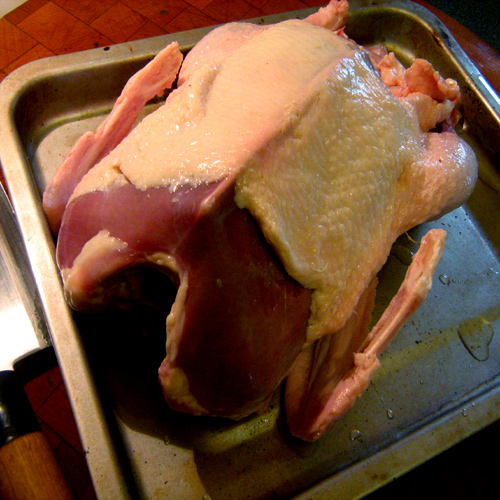
He's a little beat up but basically intact. I took the skin and legs off:
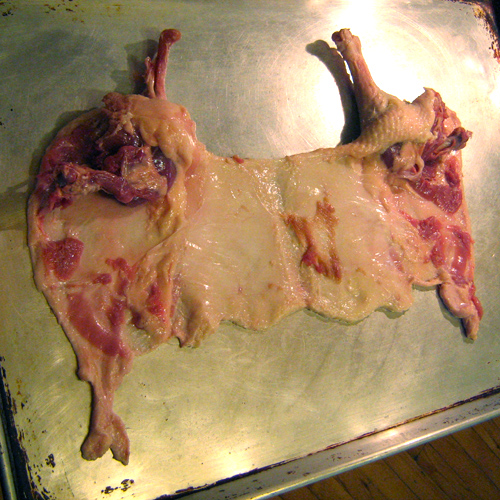
The breasts got marinated in orange juice and olive oil for a future barbecue:
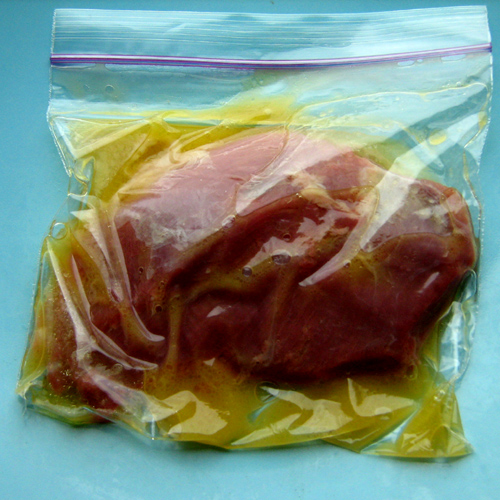
The carcass, wings and legs went into the steamer while the breasts overnighted in the fridge. The cooked wing and leg meat was set aside and the steamer broth was filtered and frozen for a future soup. I chopped up the the cooked meat and mixed it with onions, garlic and bread crumbs to make a stuffing to be rolled in the skin -- which I think qualifies as a gallotine. I baked two skin-clad rolls at 375F until they looked golden and crisp.
The wife took my camera to her soccer game so there's no final reveal.
 One roll looked fine and sliced well, but the other one arched and contorted as it baked. I'll use string sutures and less stuffing next time.
One roll looked fine and sliced well, but the other one arched and contorted as it baked. I'll use string sutures and less stuffing next time. -
My restaurant just got in a bag of these guys, and they're pretty intimidating. I think we might soak them in milk to draw some of the blood out, and then treat them like sweetbreads. We have never cooked them before, so the sweetbread approach (soak, boil, clean, slice, and pan fry) is something we hope will work. They have been in our freezer for a while, but I will update once we cook them. We also just got in some sort of penis, I think a bison, it is called a pizzar (something like that). So if anybody has any suggestions for cooking these please let me know.
I think if I had to eat an animal nose to tail, the penis would the very last part.
I always soak organ meat -- probably more than I really need to. Getting the blood out, yes, but also to remove whatever fluids that may linger depending on the organ. It's critical for kidneys -- the "off odor" is nasty.
The only place I've seen penises for sale is at the pet store. They're brown, stiff and leathery and intended to be dog toys called "pizzlers" or something like that. There's also somebody who makes walking canes out of them, they're four feet long with a glans handle. Not everyone can pull off an accessory like that.
-
I found some rice at The Bulk Barn called Emperor's Green Rice. Being a bulk food store there wasn't much info about the product, only how to cook it, and the adjective "young" was used:
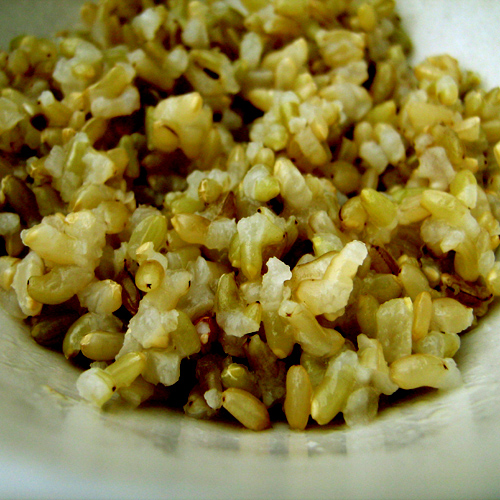
So now I'm reading a library book called "The Essential Rice Cookbook" (Whitecap Books Vancouver 2003, ISBN 1-55285-495-7) and there's no mention of green rice or Emperors. The books says on page 8 that "Rice is eaten daily by over 300 billion people." How the hell does that work? They must have meant 3 billion. There are some good recipes and images, though.
The rice pictured above was cooked in slightly salted water for 25 minutes and came out beautifully -- toothsome and flavourful.
Anbody have experience with or information about Emperor's Green Rice?
-
Like I say, anything's possible. But, Sean Combs notwithstanding, I don't think history is rife with examples of people who have successfully pursuaded everyone to stop using a reasonably well recognized and widely used designation in favor of a somewhat silly-sounding invented alternative.
The artist formerly known as Prince?

-
They look fantastic.
Have you tried leaving the skin on?
-
Foraging in a crate of lobsters at the wholesale market this morning, I found a very lively one packed with roe. The rest seemed a bit dopey so I thought why not and bought that one. It did occur to me at the time though that I've never come across lobster roe before:
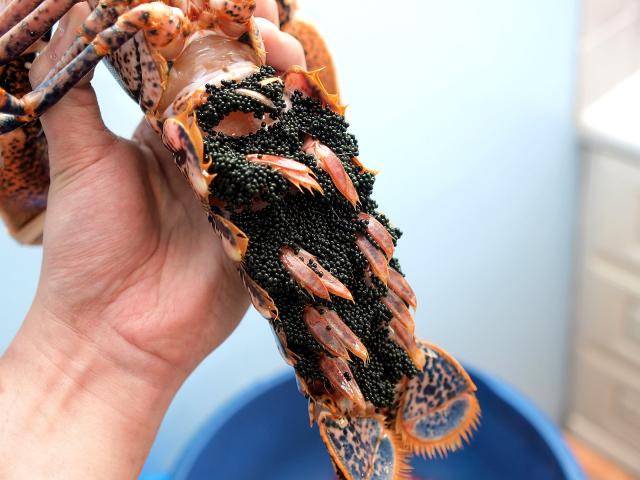
So, question is what do I do with it and how edible is it? I've scraped off most of it (you should have seen her struggle!), rinsed and salted it like caviar. I tried a little, it was bland but I'm hoping the flavour will improve by the time I get home from work in approx 9hrs. Can I cook with it or should I just use it as a garnish? Does anyone know whether the flesh of female lobsters are adversly affected by having roe?
That's a female lobster (looks like an H. americanus or H. gammarus) with a healthy amount of fertilized eggs. In Canada it's illegal to harvest a mother-to-be like that one in order to keep the wild population up. Lobster fishermen will only keep females when the eggs are still inside (i.e. not visible).
The females carry thousands of tiny black eggs inside for a year and then outside for another year tucked under the swimmerets on the tail's underside. Those eggs above look pretty big and may have been ready for release as larvae.
When a lobster is cooked, most thing turn pink including the eggs. I find just about everything inside a lobster to be delicious.
Lobsters here are currently being sold with a recommendation not to eat the eggs or the green tomalley because of the possible exposure to PST (paralytic shellfish toxin). Health Canada says there's been no reports of sickness this year but they leave the warning in place just to be safe. I think you have to eat like a dozen a day for a month to get sick. By that point PST wouldn't be my biggest concern because I'd be so fat and broke.
AFIC you'd be dishonouring that lobster's family by not eating all those yummy eggs.
-
My market gets lamb fries from time to time. I've never bought a pair (they always come in pairs, how 'bout that?) nor have I ever seen them on a menu or at somebody's place for dinner. I don't need a dedicated cookbook but I will give them a try one of these days . . .
-
I keep a small Styrofoam cooler in my trunk for carting home fish or other items that I want to keep cold
That's a good idea. Like others, I've got a bunch of reusable grocery bags in the trunk but I've also got one that's made from quilted foil-like plastic material - prevents defrosting for 3 hours.
-
The back of my car has no food, just empty packages: little raisin boxes, water bottles, granola bar wrappers, juice boxes, etc.
When I worked in Northern Ontario I used to drive around with an empty cooler and a fishing rod.
-
I don't really have a "sure thing" because I'm always going through some kind of new kick. These days I like to serve dinner guests something grilled, something steamed and something baked. I'm also a fan of having all the food on the table in communal bowls and plates. I give them smallish plates so they help themselves a few times, adds to the conversation.
Can you provide more info such as occasion, type of cuisine, theme, etc?
If I had 4-6 for dinner this weekend I'd give them:
1. roasted beef marrow bones (with herb garlic bread for smearing/dipping)
2. grilled fish steaks (like char, shark, halibut)
3. oven-roasted veggies (parsnip, beet, squash, sweet potato)
4. a grain (such as quinoa, green or red rice, couscous)
-
Figger a pound a liter? Or more?
I filled a bowl with a spout to the brim with water. When I slipped in tonight's frozen flank steak, I collected the displaced water in a measuring cup:
0.295 kg = 0.375 L
1.00 L = 0.787 kg = 1.74 lbs
Looks like 1 3/4 pounds a liter, for frozen beef flank.
-
According to Blumenthal Actin and Myosin combine when rigor mortis sets in, and he states that the way to separate them is to add polyphosphate.
It's probably common knowledge, but the actin-myosin interaction is the basis of all muscular movement and it requires ATP, where P is for phosphate.
Rigor mortis is a lot like a simple muscle contraction -- but for the muscle to relax the animal has to be alive. . . or decomposing. . . or being manipulated by a crazed Charcutière.
-
How much meat is 10 liters?
That's like 2 1/2 gallons. That's a lot of links.
-
I love pickled fish, herring's my fave.
The recipe above calls for a 2 day salt and water cure, followed by a 2 week acid/spice bath. The "brine" has no salt, so maybe it's not the best word.
In my experience with herring and mackerel, it all depends on how big the fish chunks are cut. I'll bet the pike will taste pretty good after a week or even less as long as the mix has penetrated.
-
I'm willing to take a swing and risk strike three here. If the bind is indeed just a gluey mixture and not an emulsion, can someone explain the science behind broken sausages? Why is a cold temperature so crucial to that glue, and why does warmth in preparation cause it to break?
That baseball metaphor reminds me of the Yankee Stadium frank I had in 1992 -- the year my Jays went on to win the World Series. No time for nostalgia . . .
There was an episode of Good Eats a few years ago where I recall Alton Brown explaining sausage science in some detail, including the "keep it cool" bit. It's an important question, I hope the experts here will weigh in.
Like 98.6F? That's all I found in my brief'n'lazy online search.All the information I can find on myosin and meat chemistry in general refers to temperatures way above the crucial 30-50F range. -
Great thread. (True ketchup lover here.) But quite a suprise for me -- since I (chauvanistically, I admit) always think of ketchup as the all-American condiment. Thanks for that list of links to learn from!
You should try Banana Ketchup, a product I buy at my local Fillipino market
I've had banana ketchup and it's good. I'd like it more if it wasn't artificially colored red to look like tomato ketchup -- like it's trying to be something that it's not, in a veggie burger kinda way.
Ketchup is like cola or Hannah Montana -- suffering from over exposure.
-
. . . . various sausage-makers have differing quality standards, often without even realizing there is an option. A lot of places you find on the internet don't talk about keeping things cold and maintaining a good emulsion because they don't know about it, have never tried it, and are perfectly happy with the sausages they are making, though they are often what one of us would consider broken. I have happily eaten many of these sausages, but once you've really focused on the craft of making a perfect sausage, you develop an appreciation for what a top-notch sausage is supposed to be like.
Well put -- sausages can be low-tech low-brow mere sustenance, or they can be an absolute art form.
Its really difficult to stuff sausages well using a mincer (US: grinder) with a tube stuck on the front.Even with two people, its still 'skilled' - ie too difficult for my liking.
I'm comforted to know it wasn't just me. Before I bought the plastic tube stuck on the front, I tried a very large plastic pastry bag with a 3/8" nozzle -- it worked rather well.
Stuffing was a lot of fun, but before I do another batch or upgrade any equipment I'm going to hit the markets and find some artisanal charcuterie, study the appearance and aroma, then eat it slowly with my eyes closed. Plus take photos and notes.
-
Chris H, that's a handsome set-up. Have you tried taking the operation outside on a cold day so everything is hovering around the freezing point?
Are the clamps in the background related to charcuterie?
-
This is all a bit of a revelation for me.
For years I've made liver pates, terrines, sausage patties, hamburgers and meatloaf without ever thinking about emulsions. On many sausage sites like this one and this one you won't find the word emulsion, and they often recommend raising the temperature of the mixture so it'll flow better through the stuffer. My liver pate and ground beef meatloaves always seem to set properly and slice well without friability.
Is there an image around that shows a broken sausage (other than mine above) illustrating the mealy look of a failed bind?
Maybe "broken" is a continuum?
Maybe coarsely ground sausages are more forgiving?
-
Thanks HKDave, it's all making sense. I can see why a large diameter, fine grain sausage relies on an good bind and intact emulsion. I imagine broken baloney with a 5" diameter would be granular and crumbly, and impossible to slice thinly without falling apart.
There must be a subset of non-emulsified sausages -- including my attempt above. The fried version was just like any other diner breakfast sausage.
How's this for a statement: A homemade hamburger patty is typically made by shaping ground beef into a disk. A processed hamburger patty is beef-based emulsion akin to a sausage.
-
Yikes!
But for a chef to die like that . . . . there are worse ways to go.
-



Duck: The Topic
in Cooking
Posted
Finding good groceries at good prices is my idea of fun.
Our regional version of Loblaws (Canada's largest retailer ahead of WalMart and HBC) is Atlantic Super Store (ASS?). My store always has lots of 1/2 price red meat and poultry. It's usually smaller market stuff like lamb, goat and offal. Sometimes it's just to make shelf room for incoming orders.
If something looks and smells suspicious I won't touch it, especially seafood. Beef, on the other hand, is almost always underaged and actually gets better with time in my fridge.
I usually hit the markets 3 times a week so the "cook right away" thing works for me.